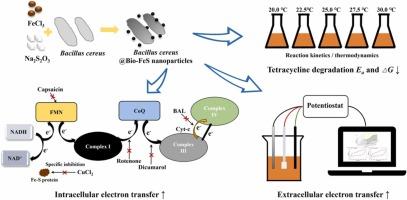Enhanced tetracycline degradation through electron transfer activated by Bacillus cereus synthesized bio-FeS nanoparticles
IF 11.3
1区 环境科学与生态学
Q1 ENGINEERING, ENVIRONMENTAL
引用次数: 0
Abstract
The synthesis of bio-FeS nanoparticles (NPs) was generally using Gram-negative bacteria and mostly in anaerobic systems, thus limiting their application in the degradation of toxic wastewater. In this study, we successfully synthesized bio-FeS NPs for the first time using the resilient Gram-positive bacterium Bacillus cereus, with the objective of investigating the mechanism of promoting electron transfer in the aerobic/anaerobic degradation of tetracycline (TC). The degradation efficiency of TC was increased by 2.84 and 4.74 times, respectively, under aerobic and anaerobic conditions. Furthermore, the bio-FeS NPs were observed to significantly reduce the activation energy and Gibbs free energy, especially under aerobic conditions. It was found that bio-FeS NPs promoted intracellular electron transfer mainly through activating or replacing the Fe-S centers. The bio-FeS NPs significantly increased ETS activity and NADH levels, indicating that the dehydrogenase activity and intracellular electron transfer efficiency were increased. The bio-FeS NPs formed electron transfer channels inside and outside the cell, provided an effective way for the transfer of electron shuttles from intracellular to extracellular, and improved the extracellular redox activity. This study offered new insights and theories into the role of Gram-positive bacteria in the synthesis of bio-FeS NPs for the remediation of toxic wastewater.

蜡样芽孢杆菌合成的生物fes纳米颗粒激活电子转移增强四环素降解
生物燃料纳米颗粒(NPs)的合成通常是利用革兰氏阴性菌,并且主要在厌氧系统中进行,因此限制了其在有毒废水降解中的应用。本研究首次利用具有弹性的革兰氏阳性杆菌蜡样芽孢杆菌成功合成了生物fes NPs,目的是研究在四环素(TC)的好氧/厌氧降解过程中促进电子转移的机制。在好氧和厌氧条件下,对TC的降解效率分别提高了2.84倍和4.74倍。此外,观察到生物fes NPs显著降低活化能和吉布斯自由能,特别是在好氧条件下。研究发现,生物- fes NPs主要通过激活或取代Fe-S中心来促进细胞内电子转移。生物fes NPs显著提高了ETS活性和NADH水平,表明脱氢酶活性和细胞内电子转移效率提高。生物fes NPs在细胞内外形成了电子传递通道,为电子穿梭体从细胞内向细胞外传递提供了有效途径,提高了细胞外氧化还原活性。本研究为革兰氏阳性菌在合成生物fes NPs修复有毒废水中的作用提供了新的见解和理论。
本文章由计算机程序翻译,如有差异,请以英文原文为准。
求助全文
约1分钟内获得全文
求助全文
来源期刊

Journal of Hazardous Materials
工程技术-工程:环境
CiteScore
25.40
自引率
5.90%
发文量
3059
审稿时长
58 days
期刊介绍:
The Journal of Hazardous Materials serves as a global platform for promoting cutting-edge research in the field of Environmental Science and Engineering. Our publication features a wide range of articles, including full-length research papers, review articles, and perspectives, with the aim of enhancing our understanding of the dangers and risks associated with various materials concerning public health and the environment. It is important to note that the term "environmental contaminants" refers specifically to substances that pose hazardous effects through contamination, while excluding those that do not have such impacts on the environment or human health. Moreover, we emphasize the distinction between wastes and hazardous materials in order to provide further clarity on the scope of the journal. We have a keen interest in exploring specific compounds and microbial agents that have adverse effects on the environment.
 求助内容:
求助内容: 应助结果提醒方式:
应助结果提醒方式:


